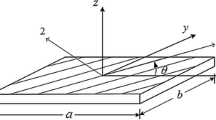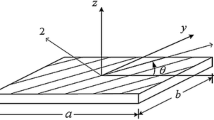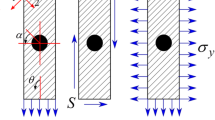Abstract
Laminated plates with holes are often used in industrial applications such as aeronautics, automobiles, and marine. It is necessary to present a study of the combined effect of deformation theories and thickness variation for the laminated plate with a hole. This manuscript considers analysis theories named: Kirchhoff, layer-wise, and Reissner-Mindlin, to study their validity for different thickness aspect ratios under transverse compression loading. Studies are conducted on CFRP laminate (symmetric cross-ply and quasi-isotropic), and the performed numerical (FEM) analysis processes are validated through existing literature. Transverse shear, circumferential, radial, and radial-hoop stress variations with stress concentration factors are presented along the thickness and around the hole configurations (18 cases are covered) of the plate. Also, the resultant effects are discussed on in-plane, and out-of-plane stresses for laminates to specify the selection of design conditions (theory, thickness, model, and laminates). This research may provide engineers and researchers with various assessments and design insight for laminate structures with a hole.
Similar content being viewed by others
References
N.-H. Minh and W. Becker, Open circular hole in a finite plate under tension treated by airy stress function method, Anal. Shells, Plates, Beams, Springer, Cham (2020), https://doi.org/10.1007/978-3-030-47491-1_16.
R. B. Heywood, Designing by Photoelasticity, Chapman and Hall, London (1952).
W. D. Pilkey, D. F. Pilkey and Z. Bi, Peterson’s Stress Concentration Factors, Fourth ed., Wiley (2020).
R. E. Peterson, Stress Concentration Factors, John Wiley & Sons (1997).
W.-D. Tseng and J.-Q. Tarn, Three-dimensional solution for the stress field around a circular hole in a plate, J. Mech., 30 (2014) 611–624, https://doi.org/10.1017/jmech.2014.48.
R. Dimitri, N. Fantuzzi, F. Tornabene and G. Zavarise, Innovative numerical methods based on SFEM and IGA for computing stress concentrations in isotropic plates with discontinuities, Int. J. Mech. Sci., 118 (2016) 166–187.
M. Jafari and E. Ardalani, Stress concentration in finite metallic plates with regular holes, Int. J. Mech. Sci., 106 (2016) 220–230.
N. Bojic and Z. Jugovic, Stress concentration in plates with one hole, Sixth International Symposium about Forming and Design in Mechanical Engineering (2010) 73–78.
Z. Yang, C. B. Kim, C. Cho and H. G. Beom, The concentration of stress and strain in finite thickness elastic plate containing a circular hole, Int. J. Solids Struct., 45 (2008) 713–731, https://doi.org/10.1016/j.ijsolstr.2007.08.030.
Z. Yang, The interaction of holes on stress and strain concentrations in uniaxially loaded tensile plates, Appl. Mech. Mater., 268–270 (2013) 767–771, https://doi.org/10.4028/www.scientific.net/amm.
N. K. Jain and N. D. Mittal, Finite element analysis for stress concentration and deflection in isotropic, orthotropic and laminated composite plates with central circular hole under transverse static loading, Mater. Sci. Eng. A, 498 (2008) 115–124, https://doi.org/10.1016/j.msea.2008.04.078.
S. C. Tan, Finite-width correction factors for anisotropic plate containing a central opening, J. Compos. Mater., 22 (1988) 1080–1097, https://doi.org/10.1177/002199838802201105.
N. J. Hoff and C. Muser, Stress concentration factors for cylindrically orthotropic plates, J. Compos. Mater., 16 (1982) 313–317, https://doi.org/10.1177/002199838201600405.
W. Zhen and C. Wanji, Stress analysis of laminated composite plates with a circular hole according to a single-layer higher-order model, Compos. Struct., 90 (2009) 122–129, https://doi.org/10.1016/j.compstruct.2009.02.010.
B. A. Bednarcyk, J. Aboudi and P. W. Yarrington, Determination of the Shear Stress Distribution in a Laminate From the Applied Shear Resultant — A Simplified Shear Solution, NASA, USA (2007), https://doi.org/10.13140/2.1.3629.9521.
J. S. Ahn, P. K. Basu and K. S. Woo, Hierarchic layer models for anisotropic laminated plates, KSCE J. Civ. Eng., 15 (2011) 1067–1080, https://doi.org/10.1007/s12205-011-1142-8.
S. Ren and G. Zhao, High-order layerwise formulation of transverse shear stress field for laminated composite beams, AIAA J, 57 (2019) 2171–2184, https://doi.org/10.2514/1.J057412.
N. Grover, D. K. Maiti and B. N. Singh, Flexural behavior of general laminated composite and sandwich plates using a secant function based shear deformation theory, Lat Am J. Solids Struct, 11 (2014) 1275–1297, https://doi.org/10.1590/S1679-78252014000700011.
T. Özben and N. Arslan, FEM analysis of laminated composite plate with rectangular hole and various elastic modulus under transverse loads, Appl Math Model, 34 (2010) 1746–1762, https://doi.org/10.1016/j.apm.2009.09.020.
P. H. Shah and R. C. Batra, Through-the-thickness stress distributions near edges of composite laminates using stress recovery scheme and third order shear and normal deformable theory, Compos Struct, 131 (2015) 397–413, https://doi.org/10.1016/j.compstruct.2015.05.041.
Z. Wu, H. Zhu and W. J. Chen, An advanced higher-order theory for laminated composite plates with general lamination angles, Acta Mech Sin, 27 (2011) 720–729, https://doi.org/10.1007/s10409-011-0455-7.
A. S. Sayyad and Y. M. Ghugal, Effect of stress concentration on laminated plates, J. Mech, 29 (2013) 241–252, https://doi.org/10.1017/jmech.2012.131.
Y. M. Ghugal and S. K. Kulkarni, Thermal response of symmetric cross-ply laminated plates subjected to linear and non-linear thermo-mechanical loads, J. Therm Stress, 36 (2013) 466–479, https://doi.org/10.1080/01495739.2013.770664.
V. V. Vasil’ev and L. V. Fedorov, Geometric elasticity problem of stress concentration in a plate with a circular hole, Mech Solids, 43 (2008) 528–538, https://doi.org/10.3103/S002565440804002X.
J.-H. Kang, Exact solutions for stresses, strains, and displacements of a rectangular plate with an arbitrarily located circular hole subjected to in-plane bending moment, Int. J. Mech. Sci., 89 (2014) 482–486, https://doi.org/10.1016/j.ijmecsci.2014.10.019.
R. P. Khandelwal, A. Chakrabarti and P. Bhargava, An efficient FE model and least square error method for accurate calculation of transverse shear stresses in composites and sandwich laminates, Compos Part B Eng., 43 (2012) 1695–1704, https://doi.org/10.1016/j.compositesb.2012.01.030.
H. Zhang, A. N. Dickson, Y. Sheng, T. McGrail, D. P. Dowling and C. Wang, Failure analysis of 3D printed woven composite plates with holes under tensile and shear loading, Compos Part B Eng., 186 (2020) 107835, https://doi.org/10.1016/j.compositesb.2020.107835.
C. Huang, M. He, Y. He, J. Xiao, J. Zhang and S. Ju, Exploration relation between interlaminar shear properties of thin-ply laminates under short-beam bending and meso-structures, J. Compos Mater, 52 (2018) 2375–2386, https://doi.org/10.1177/0021998317745586.
T. Ogasawara, S. Hanamitsu, T. Ogawa, S. Y. Moon, Y. Shimamura and Y. Inoue, Mechanical properties of cross-ply and quasi-isotropic composite laminates processed using aligned multi-walled carbon nanotube/epoxy prepreg, Adv Compos Mater, 26 (2017) 157–168, https://doi.org/10.1080/09243046.2016.1226688.
C. T. Wang, T. S. Hsieh, H. C. Hsu, Y. C. Chen and C. C. Chiang, Curing monitoring of cross-ply and quasi-isotropic-ply carbon fiber/epoxy composite material with metal-coated fiber Bragg grating sensors, Optik (Stuttg), 184 (2019) 490–498, https://doi.org/10.1016/j.ijleo.2019.04.126.
S. Timoshenko and J. N. Goodier, Theory of Elasticity, McGraw-Hill Book Company, New York (1951).
E. Reissner, On the theory of bending of elastic plates, J. Math Phys, 23 (1944) 184–191.
R. Mindlin, Influence of rotary inertia and shear on flexural motion of isotropic elastic plates, ASME J. Appl Mech, 18 (1951) 31–38.
B. F. Vlasov, On one case of bending of rectangular thick plates, Vestn Mosk Univ., 2 (1957) 25–34 (in Russian).
M. Levinson, An accurate, simple theory of the statics and dynamics of elastic plates, Mech Res Commun, 7 (1980) 343–350.
M. V. V. Murthy, An Improved Transverse Shear Deformation Theory for Laminated Anisotropic Plates, NASA Technical Paper 1903, NASA, USA (1981).
G. Jemielita, Technical theory of plates with moderate thickness, Eng. Trans., 23 (1975) 483–499.
R. Schmidt, A refined nonlinear theory of plates with transverse shear deformation, J. Indian Math Soc., 27 (1977) 23–38.
J. N. Reddy, A simple higher-order theory for laminated composite plates., J. Appl Mech Trans ASME, 51 (1984) 745–752, https://doi.org/10.1115/1.3167719.
G. Shi, K. Y. Lam, T. E. Tay and J. N. Reddy, Assumed strain quadrilateral C0 laminated plate element based on third-order shear deformation theory, Struct Eng. Mech, 8 (1999) 623–637, https://doi.org/10.12989/sem.1999.8.6.623.
R. M. J. Groh and P. M. Weaver, Static inconsistencies in certain axiomatic higher-order shear deformation theories for beams, plates and shells, Compos Struct, 120 (2015) 231–245, https://doi.org/10.1016/j.compstruct.2014.10.006.
B. A. Djalil, B. Hichem, B. A. Anis and B. K. Halim, A new higher order shear and normal deformation theory for bending analysis of advanced composite plates, Third Int. Conf. Energy, Mater. Appl. Energ. Pollut., Constantine, Algeria (2016) 640–646.
E. Carrera, S. Brischetto, M. Cinefra and M. Soave, Effects of thickness stretching in functionally graded plates and shells, Compos Part B Eng., 42 (2011) 123–133, https://doi.org/10.1016/j.compositesb.2010.10.005.
A. M. A. Neves, A. J. M. Ferreira, E. Carrera, C. M. C. Roque, M. Cinefra and R. M. N. Jorge, A quasi-3D sinusoidal shear deformation theory for the static and free vibration analysis of functionally graded plates, Compos Part B Eng., 43 (2012) 711–725, https://doi.org/10.1016/j.compositesb.2011.08.009.
K. P. Soldatos, A transverse shear deformation theory for homogeneous monoclinic plates, Acta Mech, 94 (1992) 195–220, https://doi.org/10.1007/BF01176650.
M. Karama, K. S. Afaq and S. Mistou, Mechanical behaviour of laminated composite beam by the new multi-layered laminated composite structures model with transverse shear stress continuity, Int. J. Solids Struct, 40 (2003) 1525–1546, https://doi.org/10.1016/S0020-7683(02)00647-9.
M. Aydogdu, Comparison of various shear deformation theories for bending, buckling, and vibration of rectangular symmetric cross-ply plate with simply supported edges, J. Compos Mater, 40 (2006) 2143–2155, https://doi.org/10.1177/0021998306062313.
H. Saidi, A. Tounsi and A. E. A. Adda.Bedia, A hyperbolic shear and normal deformation theory for deflection and stresses of FGM sandwich plate, CSNDD 2016 - International Conference on Structural Nonlinear Dynamics and Diagnosis, 83 (2016).
M. Di Sciuva, An improved shear-deformation theory for moderately thick multilayered anisotropic shells and plates, J Appl. Mech. Trans. ASME, 54 (1987) 589–596, https://doi.org/10.1115/1.3173074.
E. Carrera, Theories and finite elements for multilayered, anisotropic, composite plates and shells, Arch Comput Methods Eng. State Art Rev., 9 (2002) 87–140.
E. Carrera and G. Giunta, Refined beam theories based on a unified formulation, Int. J. Appl. Mech., 2 (2010) 117–143, https://doi.org/10.1142/S1758825110000500.
Y. M. Ghugal and R. P. Shimpi, A review of refined shear deformation theories of isotropic and anisotropic laminated plates, J. Reinf Plast Compos, 21 (2002) 775–813, https://doi.org/10.1177/073168402128988481.
M. I. Izzi, A. Catapano and M. Montemurro, Strength and mass optimisation of variable-stiffness composites in the polar parameters space, Struct Multidiscip Optim, 64 (2021) 2045–2073, https://doi.org/10.1007/s00158-021-02963-7.
G. A. Fiordilino, M. I. Izzi and M. Montemurro, A general isogeometric polar approach for the optimisation of variable stiffness composites: application to eigenvalue buckling problems, Mech Mater, 153 (2021) 103574, https://doi.org/10.1016/j.mechmat.2020.103574.
M. Montemurro and A. Catapano, A general B-spline surfaces theoretical framework for optimisation of variable angle-tow laminates, Compos Struct, 209 (2019) 561–578, https://doi.org/10.1016/j.compstruct.2018.10.094.
A. Catapano and M. Montemurro, Strength optimisation of variable angle-tow composites through a laminate-level failure criterion, J. Optim Theory Appl., 187 (2020) 683–706, https://doi.org/10.1007/s10957-020-01750-6.
A. Brugnoli, D. Alazard, V. Pommier-Budinger and D. Matignon, Port-hamiltonian formulation and symplectic discretization of plate models part ii: kirchhoff model for thin plates, Appl. Math Model, 75 (2019) 961–981, https://doi.org/10.1016/j.apm.2019.04.036.
J. M. Whitney and A. W. Leissa, Analysis of a simply supported laminated anisotropic rectangular plate, AIAA J., 8 (1970) 28–33, https://doi.org/10.2514/3.5601.
E. Oñate, Thick/thin plates, Reissner-Mindlin theory, Struct. Anal. with Finite Elem, Method Linear Statics, Springer, Dordrecht (2013) 291–381, https://doi.org/10.1007/978-1-4020-8743-1_6.
E. J. Barbero, J. N. Reddy and J. Teply, An accurate determination of stresses in thick laminates using a generalized plate theory, Int. J. Numer Methods Eng., 29 (1990) 1–14, https://doi.org/10.1002/nme.1620290103.
J. M. Whitney and N. J. Pagano, Shear deformation in heterogeneous anisotropic plates, J Appl. Mech., 37 (1970) 1031–1036, https://doi.org/10.1115/1.3408654.
J. N. Reddy and W. C. Chao, A comparison of closed-form and finite-element solutions of thick laminated anisotropic rectangular plates, Nucl. Eng. Des., 64 (1981) 153–167, https://doi.org/10.1016/0029-5493(81)90001-7.
E. J. Barbero, Introduction to Composite Materials Design, Third Ed., CRC Press (2017) https://doi.org/10.1201/9781315296494.
G. Kirchhoff, Über das Gleichgewicht und die Bewegung einer elastischen scheibe, J. Reine Ang Math, 40 (1850) 51–88.
J. N. Reddy, On the generalization of displacement-based laminate theories, Appl. Mech Rev., 42 (1989) 213–322, https://doi.org/10.1115/1.3152393.
J. Álvarez-Pérez and F. Peña, Mindlin-reissner analytical model with curvature for tunnel ventilation shafts analysis, Mathematics, 9 (2021) 1–17, https://doi.org/10.3390/math9101096.
Y. Hodhigere, J. S. Jha, A. Tewari and S. Mishra, Finite element analysis-based approach for stress concentration factor calculation, Proc. Fatigue, Durab. Fract. Mech. (2018) 1–6, https://doi.org/10.1007/978-981-10-6002-1_1.
Y. Kim and J. Park, A theory for the free vibration of a laminated composite rectangular plate with holes in aerospace applications, Compos Struct, 251 (2020) 112571, https://doi.org/10.1016/j.compstruct.2020.112571.
Dassault Systèmes, ABAQUS Documentation 6.14, Dassault Systèmes, USA.
N. J. Pagano, Exact solutions for rectangular bidirectional composites and sandwich plates, J. Compos Mater, 4 (1970) 20–34, https://doi.org/10.1177/002199837000400102.
Y. Xu, J. Zhu, Z. Wu, Y. Cao, Y. Zhao and W. Zhang, A review on the design of laminated composite structures: constant and variable stiffness design and topology optimization, Adv. Compos Hybrid Mater, 1 (2018) 460–477, https://doi.org/10.1007/s42114-018-0032-7.
S. A. Kumar, R. Rajesh and S. Pugazhendhi, A review of stress concentration studies on fibre composite panels with holes/cutouts, Proc. Inst. Mech. Eng. Part L. J. Mater Des. Appl., 234 (2020) 1461–1472, https://doi.org/10.1177/1464420720944571.
J. H. Crews, C. S. Hong and I. S. Raju, Stress-Concentration Factors for Finite Orthotopic Laminates With a Pin-Loaded Hole, NASA Technical Paper 1862, NASA, USA (1981).
Acknowledgments
This research is supported by Inha University.
Author information
Authors and Affiliations
Corresponding author
Ethics declarations
There is no conflict of interest.
Additional information
Chongdu Cho is a Professor of mechanical engineering at Inha University, Incheon, South Korea. His research includes many fields, especially computational mechanics, composite materials, automotive engineering, robotics, and biomedical appliances.
Vivek Kumar Dhimole is a Researcher in the Department of Mechanical Engineering at Inha University, Incheon, South Korea. His research interests include computational mechanics, composite materials modeling and analysis, and biomechanics.
Pruthvi Serrao is an Assistant Professor at the Department of Integrated System Engineering, School of Global Convergence Studies (INHA University), Incheon, Korea. His major research interests are aligned towards mechanism design and structural analysis.
Rights and permissions
About this article
Cite this article
Dhimole, V.K., Serrao, P. & Cho, C. Finite element analysis of cross-ply and quasi-isotropic laminate plates with a center hole for variable thickness under transverse loading using shear deformation theories. J Mech Sci Technol 37, 5281–5296 (2023). https://doi.org/10.1007/s12206-023-0930-7
Received:
Revised:
Accepted:
Published:
Issue Date:
DOI: https://doi.org/10.1007/s12206-023-0930-7




